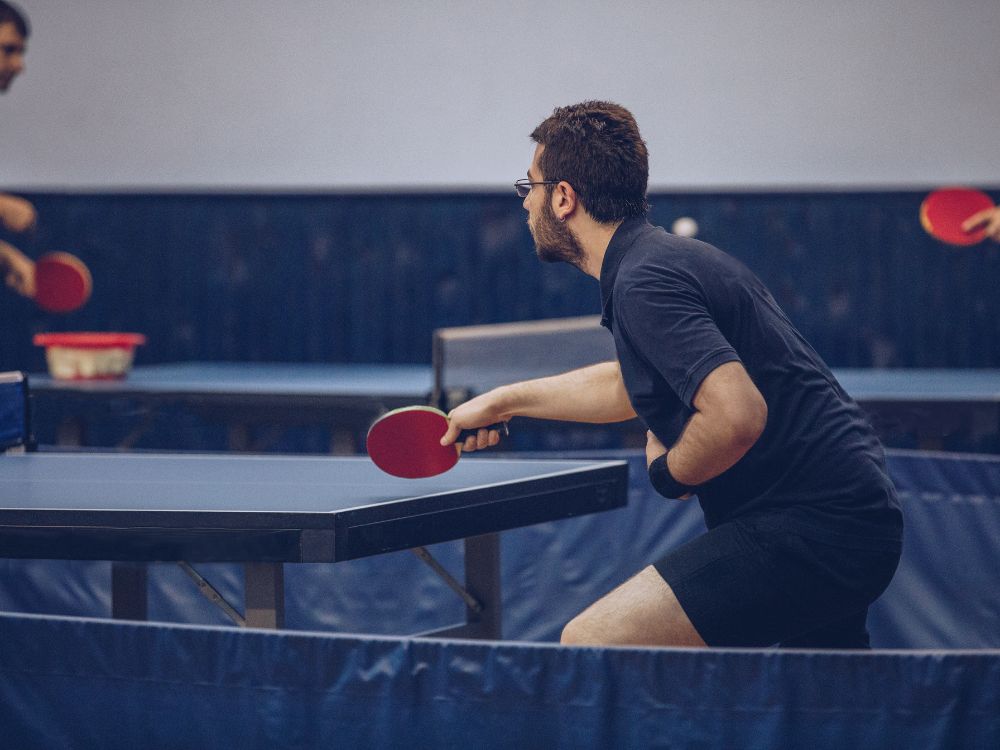In table tennis, the bat can touch the table without penalty as long as it does not move or disturb the table, as per the International Table Tennis Federation (ITTF) rules. However, the player’s free hand cannot touch the playing surface, or else the point is awarded to the opponent.
Table tennis, also known as ping-pong, is a sport loved and played by many across the globe.
It requires agility, precision, and a thorough understanding of its rules.
One question often raised by beginners and even intermediate players pertains to the legality of the bat touching the table.
This article aims to dissect this question in detail, covering various scenarios and related rules, providing you with comprehensive knowledge to ace your game.
Let’s get started!

Is Bat Touching Table Allowed in Table Tennis?
Yes, your bat or paddle can touch the table during play.
According to the ITTF rules, there’s no specific restriction against the bat touching the table.
The table is considered part of the playing area.
Therefore, as long as the bat doesn’t move the table or interfere with the ongoing rally, it’s acceptable.
What Happens If Your Bat Touches the Table?
When your bat touches the table, the game continues unaffected, assuming it didn’t move or shake the table.
The key principle here is not to disrupt the ongoing play.
The bat is an extension of the player’s hand during the rally and can therefore naturally come into contact with the table surface during aggressive play.
This rule gives players room for dynamic maneuvers without fear of rule infringements.
How Does Table Touching Affect Game Strategy?
Knowledge that the bat can touch the table without forfeiting a point can be incorporated into a player’s strategy.
For example, in a high-stakes point, if the ball comes back low and fast, instead of trying to avoid the table and possibly missing the ball, a player could aim to strike the ball in a way that their bat might touch the table, knowing that it won’t cost them a point.
The Free Hand Rule: What Happens If Your Hand Touches the Table?
In contrast to the bat, your free hand (the one not holding the bat) is not permitted to touch the table during play.
If your free hand does make contact with the playing surface during a rally, the point is instantly awarded to the opposing player.
This rule ensures fair play and prevents players from gaining an unfair advantage by potentially stabilizing themselves with their free hand.
Can a Player Lean on the Table in Table Tennis?
No, a player cannot lean on the table during an active rally.
As per ITTF rules, the player’s free hand or any other body part should not touch the playing surface during the rally.
Any such contact results in an instant point awarded to the opponent. The rules encourage player agility, quick reflexes, and maintaining a fair distance from the table.
Can the Bat Touch the Net in Table Tennis?
Just as the bat is allowed to touch the table, there is no rule against the bat touching the net during a rally.
However, any movement or disturbance of the net during play by the bat would result in the loss of the point.
The principle here remains the same: any disruption of ongoing play is penalized.
What If the Ball Hits the Bat Holder’s Hand?
Interestingly, if the ball strikes the hand holding the bat, play continues as normal.
The ITTF rules consider the bat and the hand holding it as one entity.
Therefore, if a ball hits the bat-holding hand, it’s the same as hitting the bat itself.
What are Some Common Misconceptions in Table Tennis?
Many players mistakenly believe that the bat touching the table during play will cost them a point.
Another common misconception is that if the ball hits the bat-holder’s hand, it’s a fault.
By debunking these misconceptions, players can improve their understanding and potentially their performance.
What Other Actions Can Cost a Point in Table Tennis?
There are other actions that can lead to the loss of a point.
For instance, if the ball touches anything other than the net or the opponent’s half of the table after serving, the server loses the point.
Also, if the ball touches the player or anything the player wears or carries before it bounces on the opponent’s half of the table, the player loses the point.
How Do These Rules Apply in Doubles Play?
In doubles play, all the rules discussed above apply, but there are additional rules specific to doubles play.
For instance, players must take turns to hit the ball, and the serve must be delivered from the right-hand court to the opponent’s right-hand court.
In conclusion, table tennis rules clearly state that the bat is allowed to touch the table, while the player’s free hand is not.
These rules aim to ensure fair play and maintain the dynamic and agile nature of the sport.
Understanding these nuances can significantly improve your game strategy and performance.
With this knowledge in hand, you’re better equipped to tackle any rally that comes your way on the ping-pong table!